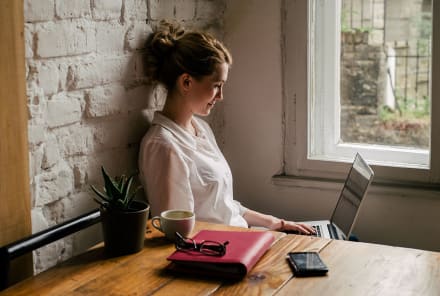Advertisement
6 Ways To Reduce Low Back Pain If You Spend A Lot Of Time Sitting


The average American spends around 7.7 hours of their day sitting1, according to some surveys—a number I find myself nodding my head along with. As an occupational therapist and writer, emailing, researching, reading, typing, and taking calls usually keep me seated for most of the day. Even self-care hobbies like journaling, watching films, and making art often involve lengthy stretches on a chair or couch.
At the end of the day, long periods of sitting are inevitable for many people—especially those with mobility limitations, chronic conditions, or disabilities.
Fortunately, a few simple techniques can mitigate some of the negative side effects of all that sitting, including stiffness, soreness, and lower back pain. Let's go over a few of my favorites that don't involve shelling out for walking pads or ergonomic furniture (although both of these can be helpful too!).
The health risks of prolonged sitting
At this point, you've likely come across the phrase "sitting is the new smoking"—and there's some truth to it.
The CDC2 reports that living a sedentary lifestyle (as 28% of adults over 50 do3) increases one's risk of chronic conditions such as heart disease, cancer, and Type 2 diabetes. In contrast, those who sit less report fewer chronic diseases, better mood and sleep quality, and enhanced daily functioning.
Spending large amounts of time sitting can also increase one's risk of lower back pain. The WHO highlighted that lower back pain impacted 619 million people globally in 20204, with projections reaching 843 million by 2050. Lower back pain often begins with stiffness, especially in joints like the hip or spine. It's the foremost cause of disability globally, affecting people across genders and ages. And it significantly influences overall life quality: Chronic pain has been linked to anxiety, depression, fatigue, trouble falling asleep, and mood changes.
Unfortunately, there are limited solutions to it due to the way we process pain. Pain is complex—no specific, localized area in the brain is responsible for its processing. Factors like mood and individual tolerance5 influence our perception of pain and modulate how we experience it.
Strategies for improving posture & reducing pain if you sit a lot
Sitting can come with health consequences, but for most people, standing all day is not an option. We need to sit to engage in major parts of life, such as working, learning, dining with friends, and doing our hobbies. And that's OK. Here are six low-cost ways to begin to ease stiffness and low back pain from excessive sitting:
Stay active
The best way to counteract time spent sitting is to move your body. Experts recommend aiming for 150-300 minutes of moderate-intensity exercise throughout the week, supplementing with resistance training to counteract the drawbacks of sitting.
Exercise should vary for different bodies and needs. Most importantly, it should be enjoyable. Flowing through a vinyasa yoga session, gardening, doing water aerobics, and dancing are all ways to achieve the benefits of moderate-intensity exercise. A little movement can go a long way; even 10 minutes can make a difference.
Tracking your time seated (like you might already track your step count) can give you a sense of your baseline and help you set more tailored movement goals.
Strengthen your core
Training the deep core muscles helps support your trunk while seated. A strong core supports your spine, reducing stress on intervertebral discs and joints. A study with 30 participants with lower back pain demonstrated a significant reduction in pain and decreased trunk muscle fatigue during seated tasks following a five-week core strengthening program6.
Incorporate movement breaks
Research indicates that just two hours7 of continuous sitting is enough to trigger immediate adverse effects, including lower back discomfort and diminished problem-solving abilities.
Getting out of your chair every 30 minutes can help prevent some of these issues. Breaks can include a quick full-body stretch, a three-minute dance break, or pacing while talking on the phone. Try incorporating deep hip stretches or foam rolling to soothe sore hip flexors.
Engage in micromovements
Small movements in your chair can be helpful if regular breaks aren't possible. If you're feeling fatigued or have limitations in mobility, chair press-ups can help to relieve pressure and soreness. Grasp the sides of the seat, then extend the arms to lift your bottom from the chair slowly. With your feet resting on the floor, you should only hold this position for a few seconds. A short chair yoga routine can also work wonders for stiffness.
Optimize your chair and desk setup
Your chair should comfortably support your back, allowing your feet to rest flat on the ground and your knees to be aligned with or slightly lower than your hips. To reduce strain, your monitor should be at eye level, about an arm's length away. Lumbar supports, footrests, and monitor stands are worthwhile investments if you spend a lot of time at your desk.
Be mindful of your sitting habits
While seated, periodically scan your body for posture. Are your legs constantly crossed? Are you sitting on one foot? Leaning toward one side or slumped toward your workspace? Having pain? These might be signs that you could benefit from a customized ergonomic assessment or visit to your health care provider.
With some back pain, especially sciatica, early intervention from a physical or occupational therapist is better than the wait-and-see approach.
The takeaway
Incorporating these six strategies can help prevent discomfort and avert some of the ailments of a sedentary lifestyle from prolonged sitting. But if you're experiencing chronic or sudden new pain, it's important to have a conversation with your health care provider. Pain is an early sign of various conditions and might be a sign of a more severe health issue.
7 Sources
- https://pubmed.ncbi.nlm.nih.gov/18303006/
- https://www.cdc.gov/physicalactivity/inactivity-among-adults-50plus/index.html
- https://www.cdc.gov/mmwr/volumes/65/wr/mm6536a3.htm?s_cid=mm6536a3_w
- https://www.who.int/news-room/fact-sheets/detail/low-back-pain
- https://www.ncbi.nlm.nih.gov/pmc/articles/PMC6832828/
- https://www.ncbi.nlm.nih.gov/pmc/articles/PMC8835683/
- https://www.mdpi.com/1660-4601/15/8/1678#B8-ijerph-15-01678
Watch Next
Enjoy some of our favorite clips from classes
Enjoy some of our favorite clips from classes
What Is Meditation?
Mindfulness/Spirituality | Light Watkins
Box Breathing
Mindfulness/Spirituality | Gwen Dittmar
What Breathwork Can Address
Mindfulness/Spirituality | Gwen Dittmar
The 8 Limbs of Yoga - What is Asana?
Yoga | Caley Alyssa
Two Standing Postures to Open Up Tight Hips
Yoga | Caley Alyssa
How Plants Can Optimize Athletic Performance
Nutrition | Rich Roll
What to Eat Before a Workout
Nutrition | Rich Roll
How Ayurveda Helps Us Navigate Modern Life
Nutrition | Sahara Rose
Messages About Love & Relationships
Love & Relationships | Esther Perel
Love Languages
Love & Relationships | Esther Perel

















